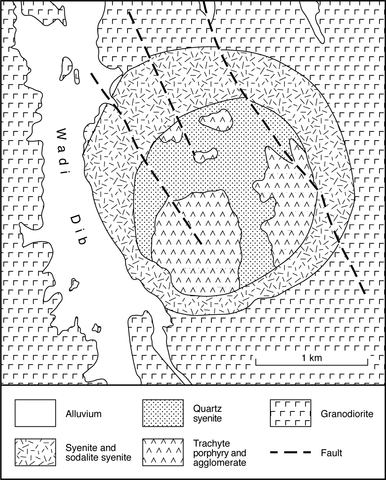stripes
A circular structure 2 km in diameter intrudes upper Palaeozoic volcanics and granites. It consists of an outer ring of feldspathoidal and a central stock of peralkaline quartz syenite overlain by trachytic lavas and agglomerates. The most abundant rock type of the outer ring comprises orthoclase, albite, aegirine-augite, sodic amphibole, biotite, zeolites, pyrochlore and apatite, but amongst these rocks are feldspathoidal syenites of perthite, sodic amphibole, sodalite and cancrinite. The central stock syenites contain 15-20% quartz, sodic amphiboles and biotite with fluorite among the accessories. This is probably the only one of the Egyptian ring complexes containing both feldspathoidal and quartz syenites. The volcanic rocks are intruded by the syenites and probably represent remnants of a former cone. They are composed essentially of alkali feldspar, aegirine-augite and sodic amphibole.
EL RAMLY, M.F., HUSSEIN, A.A.A., and FRANCIS, M.H. 1982a. The ring complex of Wadi Dib, north eastern desert, Egypt. Annals of the Geological Survey of Egypt, 12: 77-82.FRISCH, W. 1982. The Wadi Dib ring complex, Nubian Desert (Egypt) and its importance for the upper limit of the Pan-African Orogeny. Precambrian Research, 16(4): A20 (abstract). SABET, A.H., MAKSOUD, M.A.A. and NABROVENKOV, U.S. 1977. Geological setting and petrography of Wadi Dib ring intrusion, Northern Eastern Desert, Egypt. Egyptian Journal of Geology, 21: 91-102.SERENCSITS, C.M., FAUL, H., FOLAND, K.A., EL RAMLY, M.F. and HUSSEIN, A.A. 1979. Alkaline ring complexes in Egypt: their ages and relationship to tectonic development of the Red Sea. Annals of the Geological Survey of Egypt, 9: 102-16.

